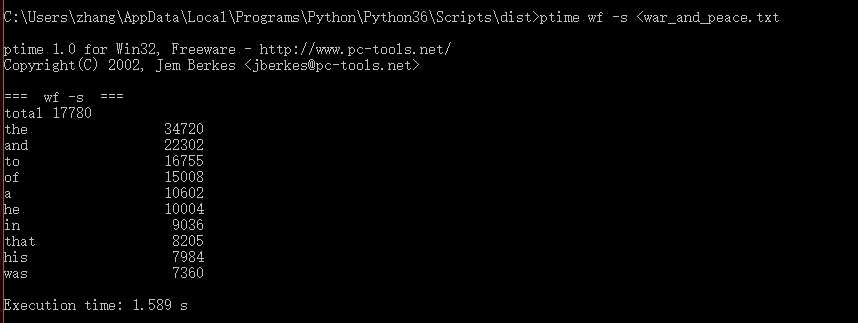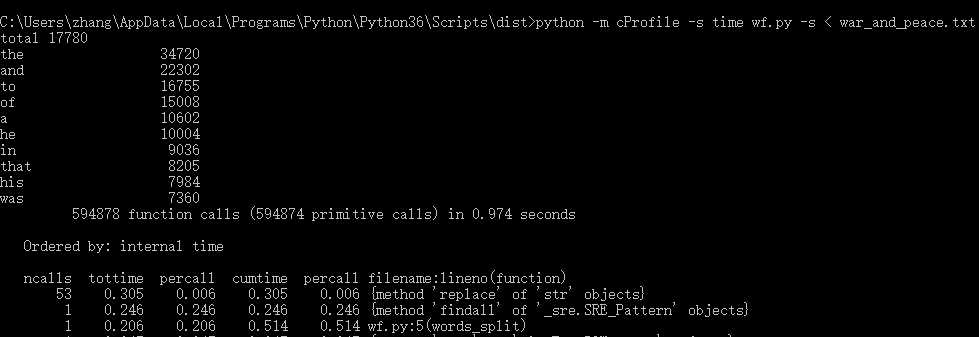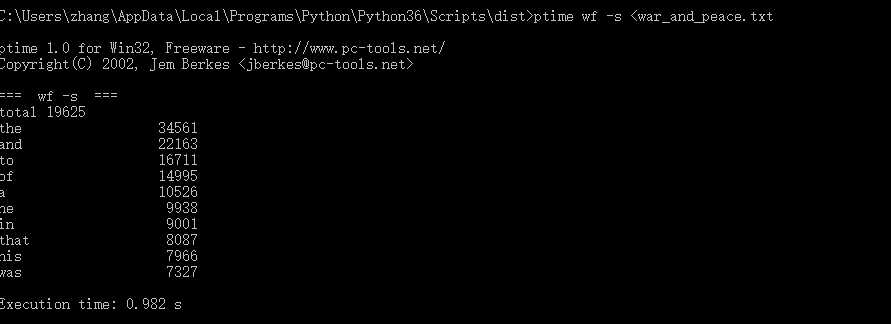作業 20180925-3 效能分析
作業要求: https://edu.cnblogs.com/campus/nenu/2018fall/homework/2145
git地址:https://git.coding.net/zhangjy982/word_count.git
要求0
第一次運行:

第二次運行:

第三次運行:

| 次數 | 消耗時間(s) |
| 第一次 | 1.589 |
| 第二次 | 2.059 |
| 第三次 | 1.681 |
| 平均 | 1.776 |
CPU參數: Intel(R) Core(TM) i5-3210M CPU @ 2.50GHz 2.50GHz
要求1
我猜測程序的瓶頸是替換文章的標點對文章進行分詞,也就是word_split(str)這一函數過程:
1 def words_split(str): 2 text = re.findall(r‘\w+‘,str) 8 count_dict = {} 9 for str in text: 10 if str in count_dict.keys(): 11 count_dict[str] = count_dict[str] + 1 12 else: 13 count_dict[str] = 1 14 count_list=sorted(count_dict.items(),key=lambdax:x[1],reverse=True) 15 return count_list
因為正則表達式的處理時間很慢,讀取文章內容產生的字符串又非常長,所以我覺得這塊應該是程序的瓶頸。根據老師課上三角函數的啟發,我的優化方案是:將正則表達式更改為標點符號的替換,因為標點符號的數量有限,在文章篇幅非常長的情況下,替換的時間比正則匹配的時間要短很多。
要求2
因為我使用的編程語言是Python,所以需要使用Python的效能分析工具,我找到了關於Python效能分析的博客並學習了其中的內容,這篇博客的地址在:
http://www.cnblogs.com/xiadw/p/7455513.html
我使用了cProfile作為Python的效能分析工具,代碼為:
1 python -m cProfile -s time wf.py -s < war_and_peace.txt
我得到的結果為:

從效能分析結果上來看我的程序耗時最長的三個函數分別是:
1."replace" of "str" object,即字符串類型的替換操作;
2."findall" of "_sre.SRE_Pattern" object,即正則匹配的findall()方法;
3.words_split(),即我自己寫的分詞函數;
要求3
根據要求2解決中得到的結論,我發現排名第一的雖然是replace()函數,但是它執行了53次(替換文本中的亂碼字符),單次的執行時間為0.305/53 = 0.005755s,而findall()函數的單次執行時間為0.246s,單次執行時間是replace的接近43倍,所以replace不是影響程序運行時間的主要因素,換句話說,也就是優化空間不大;但是正則方法就不一樣了,正則方法可以轉化,可以把正則方法轉化為replace方法,將正則方法轉化為replace函數,效果應該會有比較明顯的改善;
修改後的代碼:
1 def words_split(str): #正則表達式進行分詞改為replace 2 text = str.replace(‘\n‘,‘ ‘).replace(‘.‘,‘ ‘).replace(‘,‘,‘ ‘). 3 replace(‘!‘,‘ ‘).replace(‘\\‘,‘ ‘).replace(‘#‘,‘ ‘). 4 replace(‘[‘,‘ ‘).replace(‘]‘,‘ ‘).replace(‘:‘,‘ ‘). 5 replace(‘?‘,‘ ‘).replace(‘-‘,‘ ‘).replace(‘\‘‘,‘ ‘). 6 replace(‘\"‘,‘ ‘).replace(‘(‘,‘ ‘).replace(‘)‘,‘ ‘). 7 replace(‘—‘,‘ ‘).replace(‘;‘,‘ ‘).lower().split() 8 count_dict = {} 9 for str in text: 10 if str in count_dict.keys(): 11 count_dict[str] = count_dict[str] + 1 12 else: 13 count_dict[str] = 1 14 count_list=sorted(count_dict.items(),key=lambda x:x[1],reverse=True) 15 return count_list
要求4
新的運行效能分析截圖:

新的運行時間截圖:

要求5
待老師測評;
作業 20180925-3 效能分析
